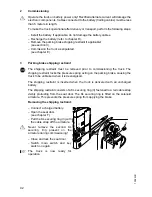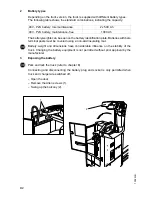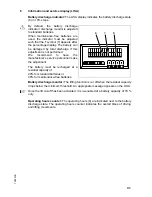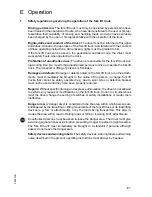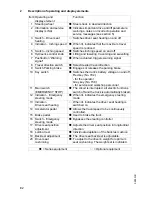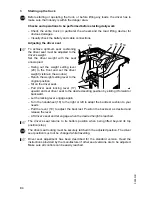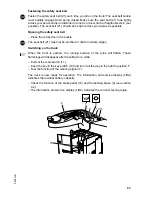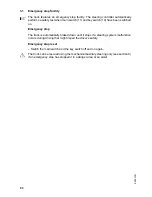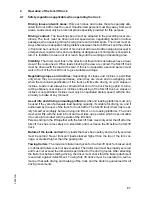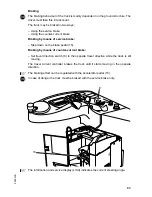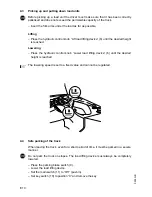
D 1
1002
.GB
D Battery - Servicing, recharging,
replacement
1
Safety regulations governing the handling of lead-acid batteries
The truck must be parked and rendered safe before any operations on batteries are
undertaken (refer to chapter E).
Servicing staff:
Recharging, servicing and replacing of batteries must only be per-
formed by qualified personnel. The instructions contained in this operating manual,
and the instructions of the manufacturer of the battery and of the battery recharging
station, must be observed when performing the above operations.
Fire protection measures:
Smoking and naked flames are not permitted when han-
dling batteries. No inflammable substances or spark-generating materials must be
present or stored within a distance of 2 meters of the truck parked for battery recharg-
ing. The location must be well ventilated and fire fighting equipment must be kept
ready.
Servicing of batteries:
The battery cell screw caps must be kept dry and clean. Ter-
minals and cable shoes must be clean, lightly greased with pole grease and must be
securely tightened. Batteries with bare terminal posts must be covered using a non-
skid insulating mat.
Disposal of the battery:
Batteries must only be disposed of as stipulated in the na-
tional environmental protection regulations or waste disposal provisions. The manu-
facturer’s specifications for the disposal must be heeded.
m
Before closing the battery hood, make sure that the battery cable cannot be dam-
aged.
f
Batteries contain dissolved acid which is toxic and caustic. For this reason, protective
clothing and goggles must be worn whenever work is undertaken on batteries. Avoid
physical contact with battery acid.
If clothing, skin or eyes accidentally come into contact with battery acid, liberally flush
the affected parts with clean water. Consult a doctor when skin or eyes come into con-
tact with battery acid. Spilled battery acid must be immediately neutralized.
m
Only batteries with closed tray may be used.
f
Battery weight and dimensions have considerable influence on operational safety of
the truck. Changing the battery equipment is not permitted without prior approval by
the manufacturer.
D 1
1002
.GB
D Battery - Servicing, recharging,
replacement
1
Safety regulations governing the handling of lead-acid batteries
The truck must be parked and rendered safe before any operations on batteries are
undertaken (refer to chapter E).
Servicing staff:
Recharging, servicing and replacing of batteries must only be per-
formed by qualified personnel. The instructions contained in this operating manual,
and the instructions of the manufacturer of the battery and of the battery recharging
station, must be observed when performing the above operations.
Fire protection measures:
Smoking and naked flames are not permitted when han-
dling batteries. No inflammable substances or spark-generating materials must be
present or stored within a distance of 2 meters of the truck parked for battery recharg-
ing. The location must be well ventilated and fire fighting equipment must be kept
ready.
Servicing of batteries:
The battery cell screw caps must be kept dry and clean. Ter-
minals and cable shoes must be clean, lightly greased with pole grease and must be
securely tightened. Batteries with bare terminal posts must be covered using a non-
skid insulating mat.
Disposal of the battery:
Batteries must only be disposed of as stipulated in the na-
tional environmental protection regulations or waste disposal provisions. The manu-
facturer’s specifications for the disposal must be heeded.
m
Before closing the battery hood, make sure that the battery cable cannot be dam-
aged.
f
Batteries contain dissolved acid which is toxic and caustic. For this reason, protective
clothing and goggles must be worn whenever work is undertaken on batteries. Avoid
physical contact with battery acid.
If clothing, skin or eyes accidentally come into contact with battery acid, liberally flush
the affected parts with clean water. Consult a doctor when skin or eyes come into con-
tact with battery acid. Spilled battery acid must be immediately neutralized.
m
Only batteries with closed tray may be used.
f
Battery weight and dimensions have considerable influence on operational safety of
the truck. Changing the battery equipment is not permitted without prior approval by
the manufacturer.
Summary of Contents for EKE 30-2 ac
Page 1: ...Operating instructions 50272276 EKE 30 2 ac G 08 02 09 03...
Page 3: ...0108 GB...
Page 7: ...0600 GB A 2...
Page 23: ...1002 GB D 6...
Page 26: ...E 3 0903 GB 1 2 17 18 12 13 14 19 15 16 3 4 5 6 7 8 9 10 11 20...
Page 37: ...0903 GB E 14...














